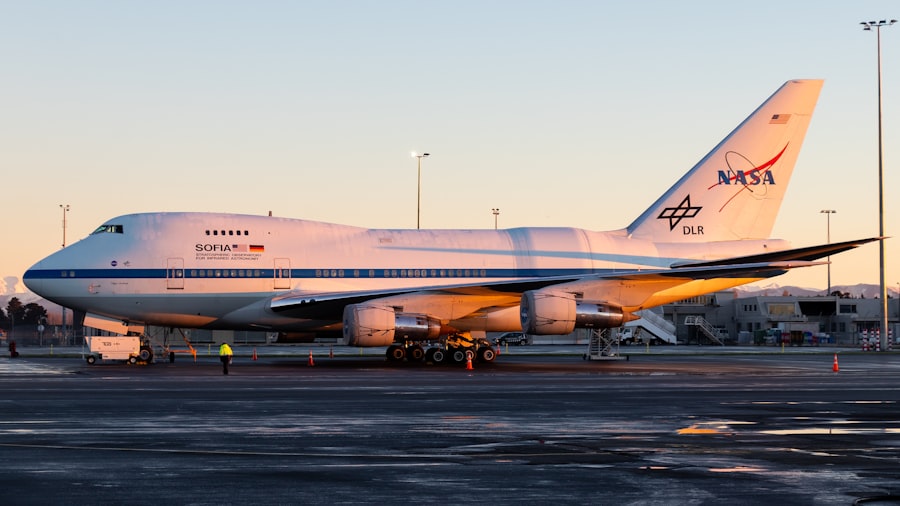Commercial aerospace technology encompasses a vast array of innovations and engineering marvels that have transformed the way we travel and connect globally. This sector is not merely about the aircraft that transport millions of passengers each year; it also includes the intricate systems, materials, and processes that ensure safety, efficiency, and sustainability in air travel. The evolution of commercial aerospace technology has been driven by a combination of factors, including the need for increased capacity, improved fuel efficiency, and enhanced passenger comfort.
As the world becomes more interconnected, the demand for air travel continues to rise, prompting the aerospace industry to innovate at an unprecedented pace. The commercial aerospace sector is characterized by its complexity and the interplay of various disciplines, including aerodynamics, materials science, avionics, and propulsion systems. Each of these fields contributes to the overall performance and safety of aircraft.
For instance, advancements in aerodynamics have led to the development of more fuel-efficient wing designs, while innovations in materials science have resulted in lighter and stronger components that enhance aircraft performance. As we delve deeper into the various facets of commercial aerospace technology, it becomes evident that this industry is at the forefront of technological advancement, continually pushing the boundaries of what is possible in aviation.
Key Takeaways
- AI is revolutionizing aerospace through enhanced design, maintenance, and operations.
- New materials and designs are improving aircraft efficiency and performance.
- Sustainable aviation technologies are driving efforts to reduce environmental impact.
- 3D printing is transforming aerospace manufacturing with faster, cost-effective production.
- Electric and hybrid aircraft, along with advanced communication systems, are shaping the future of commercial aerospace and space tourism.
The Role of Artificial Intelligence in Aerospace Technology
Artificial intelligence (AI) has emerged as a transformative force within the aerospace industry, revolutionizing various aspects of aircraft design, operation, and maintenance. One of the most significant applications of AI is in predictive maintenance, where machine learning algorithms analyze vast amounts of data from aircraft sensors to predict potential failures before they occur. This proactive approach not only enhances safety but also reduces downtime and maintenance costs for airlines.
For example, Delta Air Lines has implemented AI-driven predictive maintenance systems that have significantly improved their operational efficiency by minimizing unscheduled maintenance events. Moreover, AI is playing a crucial role in optimizing flight operations. Advanced algorithms can analyze real-time data on weather conditions, air traffic, and fuel consumption to recommend optimal flight paths and altitudes.
This capability not only enhances fuel efficiency but also contributes to reducing carbon emissions. Airlines like United Airlines are leveraging AI to optimize their flight schedules and improve on-time performance, demonstrating how technology can lead to more efficient operations while enhancing customer satisfaction.
Advancements in Aircraft Design and Materials

The design of modern aircraft has undergone a remarkable transformation over the past few decades, driven by advancements in computational fluid dynamics (CFD) and materials science. The use of sophisticated simulation tools allows engineers to model airflow around aircraft structures with unprecedented accuracy, leading to designs that minimize drag and maximize fuel efficiency. For instance, the Boeing 787 Dreamliner features a unique wing design that incorporates advanced aerodynamics principles, resulting in a 20% reduction in fuel consumption compared to previous models.
In addition to aerodynamic improvements, the materials used in aircraft construction have evolved significantly. The introduction of composite materials, such as carbon fiber reinforced polymer (CFRP), has revolutionized aircraft manufacturing. These materials are not only lighter than traditional aluminum but also offer superior strength and resistance to corrosion.
The Airbus A350 XWB is a prime example of this trend; approximately 53% of its airframe is made from composite materials, contributing to its overall efficiency and performance. As research continues into new materials and manufacturing techniques, the potential for even more innovative aircraft designs remains vast.
Sustainable Aviation: The Push for Greener Technology
| Metric | Current Value | Target/Goal | Year | Notes |
|---|---|---|---|---|
| CO2 Emissions per Passenger Kilometer | 90 grams | 50 grams | 2035 | Reduction through improved engine efficiency and sustainable fuels |
| Percentage of Sustainable Aviation Fuel (SAF) Usage | 2% | 30% | 2030 | Increase in SAF blending mandates globally |
| Electric/Hybrid Aircraft Market Share | Less than 1% | 10% | 2040 | Focus on short-haul regional flights |
| Noise Reduction (dB) | Current baseline | 10 dB reduction | 2030 | Quieter engines and airframe designs |
| Fuel Efficiency Improvement | 1.5% per year | 2% per year | 2025-2035 | Through aerodynamic and engine advancements |
| Carbon Offset Programs Participation | 15% | 50% | 2030 | Airlines investing in reforestation and carbon capture |
As concerns about climate change intensify, the aerospace industry is under increasing pressure to adopt sustainable practices and technologies. The push for greener aviation solutions has led to significant investments in research and development aimed at reducing the environmental impact of air travel. One of the most promising avenues is the development of sustainable aviation fuels (SAFs), which are derived from renewable resources such as plant materials or waste products.
These fuels can significantly reduce greenhouse gas emissions compared to traditional jet fuels. Airlines like KLM and British Airways are already incorporating SAFs into their operations as part of their commitment to sustainability. In addition to alternative fuels, manufacturers are exploring hybrid-electric propulsion systems as a means to reduce emissions further.
These systems combine traditional jet engines with electric motors powered by batteries or fuel cells, allowing for reduced fuel consumption during flight. Companies like Airbus are actively developing hybrid aircraft concepts that could enter service within the next decade. Furthermore, regulatory bodies are beginning to establish frameworks for emissions reduction targets, pushing manufacturers and airlines alike to prioritize sustainability in their operations.
The Impact of 3D Printing on Aerospace Manufacturing
3D printing technology has emerged as a game-changer in aerospace manufacturing, offering unprecedented flexibility and efficiency in producing complex components. This additive manufacturing process allows for the creation of parts with intricate geometries that would be difficult or impossible to achieve using traditional machining methods. For example, GE Aviation has successfully utilized 3D printing to produce fuel nozzles for its LEAP engines, resulting in a part that is 25% lighter and five times more durable than its traditionally manufactured counterpart.
The benefits of 3D printing extend beyond weight reduction; it also streamlines the supply chain by enabling on-demand production of spare parts. This capability is particularly valuable in the aerospace industry, where maintaining an extensive inventory of components can be costly and logistically challenging. By leveraging 3D printing technology, manufacturers can produce parts as needed, reducing lead times and minimizing waste.
As this technology continues to mature, its integration into aerospace manufacturing processes is expected to expand significantly, paving the way for more efficient production methods.
The Rise of Electric and Hybrid Aircraft

The development of electric and hybrid aircraft represents a significant shift in the aerospace industry as it seeks to address environmental concerns while enhancing operational efficiency. Electric propulsion systems offer the potential for zero-emission flights, making them an attractive option for short-haul routes where battery technology can provide sufficient range. Companies like Pipistrel have already developed electric aircraft capable of carrying passengers for short distances, demonstrating the feasibility of this technology in commercial aviation.
Hybrid aircraft take this concept further by combining electric propulsion with traditional engines, allowing for greater range and flexibility while still reducing emissions. The Airbus E-Fan X project exemplifies this approach; it aims to integrate a hybrid-electric propulsion system into a regional aircraft platform. By utilizing electric motors during takeoff and landing phases—where noise and emissions are most critical—hybrid aircraft can significantly reduce their environmental footprint while maintaining operational capabilities similar to conventional jets.
The Integration of Advanced Communication and Navigation Systems
The integration of advanced communication and navigation systems is crucial for enhancing safety and efficiency in commercial aviation. Modern aircraft are equipped with sophisticated avionics that enable real-time communication between pilots, air traffic control (ATC), and other aircraft. This connectivity is essential for managing increasingly crowded airspace and ensuring safe operations during all phases of flight.
Technologies such as Automatic Dependent Surveillance–Broadcast (ADS-B) allow aircraft to share their position data with ATC and other nearby planes, improving situational awareness and reducing the risk of mid-air collisions. Furthermore, advancements in satellite-based navigation systems have revolutionized how pilots navigate during flights. Global Navigation Satellite Systems (GNSS) provide precise positioning information that enhances route planning and allows for more efficient flight paths.
The implementation of Performance-Based Navigation (PBN) enables aircraft to fly more direct routes while adhering to safety standards, resulting in reduced fuel consumption and shorter flight times. As these technologies continue to evolve, they will play an increasingly vital role in shaping the future of commercial aviation.
The Future of Commercial Aerospace Technology: Space Tourism and Beyond
The future of commercial aerospace technology extends beyond traditional air travel into the realm of space tourism—a burgeoning industry that promises to make space accessible to private individuals. Companies like SpaceX and Blue Origin are at the forefront of this movement, developing spacecraft capable of carrying tourists on suborbital flights that offer breathtaking views of Earth from space. These ventures not only represent a new frontier for commercial aviation but also drive innovation in spacecraft design and safety protocols.
As space tourism gains traction, it is likely to spur further advancements in aerospace technology that could benefit both terrestrial aviation and space exploration. For instance, technologies developed for reusable launch systems may find applications in improving the efficiency of conventional aircraft operations. Additionally, as more companies enter the space tourism market, competition will drive innovation across various sectors within aerospace technology—leading to enhanced safety measures, improved passenger experiences, and potentially even new forms of transportation that bridge air travel with space exploration.
The intersection of commercial aerospace technology with emerging fields such as space tourism signifies an exciting era ahead for aviation enthusiasts and travelers alike. As we continue to witness rapid advancements across multiple domains within this industry, it becomes clear that the future holds limitless possibilities for innovation and exploration beyond our planet’s atmosphere.




